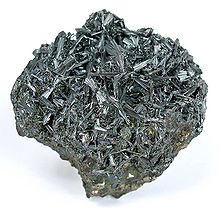Hutchinsonite
| Hutchinsonite | |
|---|---|
 Hutchinsonite, from Quiruvilca Mine, Santiago de Chuco Province, Peru. Size: 4.5×4.4×2.2 cm | |
| General | |
| Category | Sulfosalt mineral |
| Formula (repeating unit) | (Tl,Pb)2As5S9 |
| IMA symbol | Hut[1] |
| Strunz classification | 2.HD.45 |
| Crystal system | Orthorhombic |
| Crystal class | Dipyramidal (mmm) H-M symbol: (2/m 2/m 2/m) |
| Space group | Pbca |
| Identification | |
| Color | Red, pink, black |
| Crystal habit | Acicular – cccurs as needle-like crystals |
| Cleavage | {100} good |
| Fracture | Very brittle fracture producing small, conchoidal fragments |
| Mohs scale hardness | 1.5–2 |
| Luster | Sub-metallic |
| Streak | Red |
| Diaphaneity | Subtranslucent to opaque |
| Specific gravity | 4.6 |
| Optical properties | biaxial (-) |
| Refractive index | nα = 3.078 nβ = 3.176 nγ = 3.188; 2V = 37° |
| Birefringence | δ = 0.110 |
| References | [2][3][4] |
Hutchinsonite is a sulfosalt mineral of thallium, arsenic and lead with formula (Tl,Pb)2As5S9. Hutchinsonite is a rare hydrothermal mineral.
It was first discovered in a sample from Binnental, Switzerland in 1903 and named after Cambridge mineralogist Arthur Hutchinson, F.R.S. (1866–1937) in 1904.
See also
References
- ^ Warr, L.N. (2021). "IMA–CNMNC approved mineral symbols". Mineralogical Magazine. 85 (3): 291–320. Bibcode:2021MinM...85..291W. doi:10.1180/mgm.2021.43. S2CID 235729616.
- ^ Handbook of Mineralogy
- ^ Hutchinsonite at Mindat.org
- ^ Hutchinsonite at Webmineral
Further reading
- Prior, G. T. (1905). "A New Thallium Mineral". Nature. 71 (1849): 534. Bibcode:1905Natur..71Q.534P. doi:10.1038/071534b0.
- Matsushita, Y.; Takéuchi, Y. (1994). "Refinement of the crystal structure of hutchinsonite, TlPbAs5S9". Zeitschrift für Kristallographie - Crystalline Materials. 209 (6): 475. Bibcode:1994ZK....209..475M. doi:10.1524/zkri.1994.209.6.475.
- Nihon Kessho Gakkaishi. 32: 68. 1990. doi:10.5940/jcrsj.32.Supplement_68 https://doi.org/10.5940%2Fjcrsj.32.Supplement_68.
{{cite journal}}: Missing or empty|title=(help) - Solly, R. H. (1903). "On some Minerals from Binnental, Switzerland". Proceedings of the Cambridge Philosophical Society. 12: 277.
- Solly, R. H. (1905). "On some Minerals from Binnental, Switzerland" (PDF). Mineralogical Magazine: 72–. doi:10.1180/minmag.1905.014.64.03.
- Raber, Thomas; Roth, Philippe (2018). "The Lengenbach Quarry in Switzerland: Classic Locality for Rare Thallium Sulfosalts". Minerals. 8 (9): 409. Bibcode:2018Mine....8..409R. doi:10.3390/min8090409.
Wikimedia Commons has media related to Hutchinsonite.
